Manipulating time is, for me, one of the most interesting ways of framing the activity of making music. Taking sounds and allowing them to evolve, continuously changing shape and turning into something new entirely. And of course, the manipulation of time is the basis for some of the most classic, time-tested musical effects: reverbs, echoes, flangers, and more.
In this article, we're going to focus on explaining how various time-based effects work, and how they can be recreated using the Mimeophon—though in theory, all the same concepts could work with other modules or pedals as well. "Time-based" effects constitute a quite large subsection of traditional audio processing techniques, including obvious contenders like delay and reverb as well as "modulation" effects such as flangers, chorus, and vibrato. In fact, the core of all of these effects is the same: they are all based on the principle of audio repetition. Audio repetition on the scale of seconds manifests as an echo—but repetition at faster rates dives into more peculiar territory that seems to alter a sound's timbre rather than its timing.
Why Mimeophon?
Make Noise describes the Mimeophon as a Stereo Multizone Color Audio Repeater: something of a mouthful, when a simpler term like "delay" could get the point across on its own. But the fact is that Mimeophon is not a delay module, strictly speaking. Instead, its true nature lies within exploiting all of the potential applications of audio repetition, which can, of course, include delay, but also extends outward into much more extreme territory, blurring the lines between traditional effect types and turning them into something far more interesting. (A quick note: If you're curious about some of the inspiration and design considerations that led to the Mimeophon's creation, be sure to check out our interview with SoundHack's Tom Erbe.)
Though Mimeophon has a ton of features that distinguish it from typical delays, one of the most notable is its remarkably broad delay time range: with a minimum delay time of 1.3 milliseconds and a maximum of 41.796 seconds, it is vastly more capable than the average delay. Smaller delay times lend themselves to bizarre waveshaping and microsound-level manipulations, while longer times encourage exploration of echoes, looping, and time lag accumulation effects. Not only does Mimeophon provide access to this enormous range: it provides a clever means of instantly shifting from one timescale to the next, with carefully-selected delay time ranges relegated to individual overlapping ZONEs. Some zones will lend themselves to traditional delay effects, while others produce mind-bending timbral manipulations—and yet others will retrieve information from the distant past.
By carefully exploring each of the Mimeophon's ZONEs, one can access all traditional time-based effects...as well as effects as of yet unheard.
Only a Phase: Comb Filtering
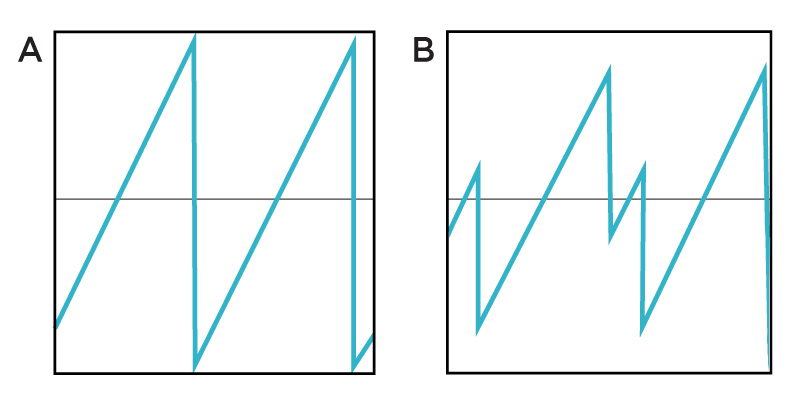 A) Saw wave; B) Interference with time-displaced version of same wave
A) Saw wave; B) Interference with time-displaced version of same wave
So let's talk about phase. In the realm of audio repetition, we can understand "phase" as being relative—it's about how separated in time two copies of a signal are. Usually, matters of phase are discussed only in very small timescales: once repetitions are hundreds of milliseconds apart or longer, the repeat can be perceived as an entirely separate entity from the original sound, but when repetitions are separated by mere milliseconds (or less), they seem to blend into one continuous sound. And this is the territory where phase cancellation makes its mark.
So what is phase cancellation? In short, combining a sound with a very slightly delayed version of itself results in constructive and destructive interference: peaks and troughs absent from the original shape that result from the addition of the delay. Often, this deformation of the original wave shape is referred to as phase cancellation, with a perceptual result called comb filtering: a loss of frequencies that earned its name due to the comb-like dips it produces in the resultant sound's overall spectral profile. In the world of studio recording, it is often a dreaded effect: the result of poor miking technique, when unexpected audio reflections result in a warped, typically undesirable translation of a source sound. In the world of electronic music, though, comb filtering is yet another tool for timbral manipulation.
 Sonogram of comb filtering with white noise
Sonogram of comb filtering with white noise
Mimeophon makes powerful use of this type of constructive and destructive interference: ZONEs 0 and 1 are the ideal place to take advantage of its spectrally peculiar effects. By increasing Repeats to introduce feedback and adjusting the Color and Halo controls, you can find a whole universe of peculiar harmonic reinforcements and destructive phase effects. With delay rates variable from 1.3ms to 20.4ms, ZONE 0 provides an essentially perfect range for comb filtering. Beyond 20ms of delay, the perceptual effects of audio repetition begin to change dramatically, especially with animated input signals (but we'll get to that shortly).
It's worth noting that most analog delay pedals or modules aren't the best at this particular effect: because their output sound tends to be much darker than the input, the effects of destructive and constructive interference often aren't very pronounced. Digital delays, on the other hand, can do this quite well: if your digital delay pedal or module can produce repeats in the range of milliseconds, this type of peculiar filtering should be possible.
Here Come the Warm Jets: Flangers Explained
Traditional comb filtering relies on a fixed amount of time displacement. With some modulation applied to the delay time, though, it becomes a different effect altogether: a flanger. Flanging effects usually involve use of a sine or triangular LFO to continuously vary the delay time, resulting in continuously evolving constructive and destructive phase cancellation. This delay time sweep and a healthy amount of feedback is the basis of the classic 1980s jet flanger effect, great for turning any sound into a swarming, sweeping mess of classic rock ethos.
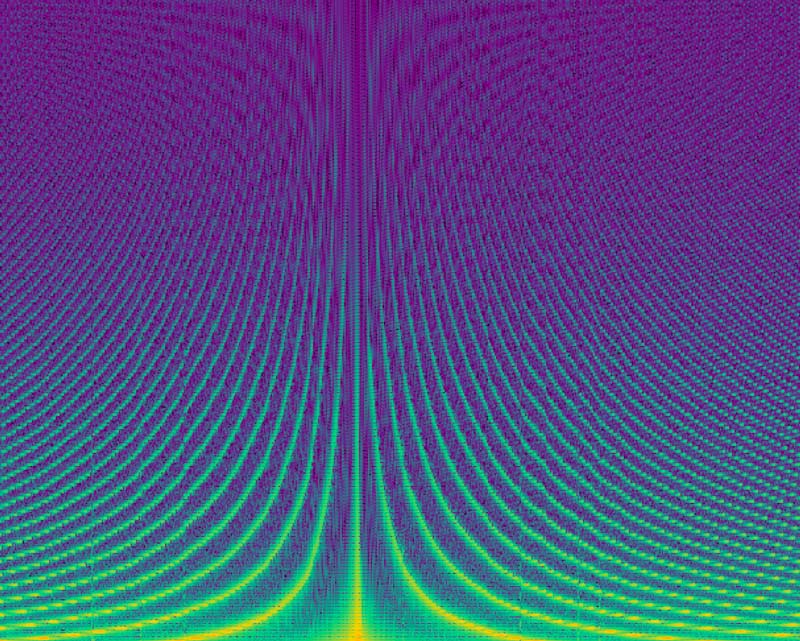 Sonogram of extreme flanging with a saw wave (in Max/MSP)
Sonogram of extreme flanging with a saw wave (in Max/MSP)
Flanging in the Mimeophon is achieved in the same time ranges as comb filtering (ZONEs 0 and 1), as they are, after all, directly related to one another. Mimeophon allows for some pretty gnarly alterations of traditional flanging effects. For instance, engaging SKEW causes modulation to affect the left and right delay lines inversely of one another: one will grow shorter as the other grows longer and vice versa, creating swirling, pulsating stereo flange effects. By engaging Flip, the delay buffer is reversed, generating an effect Make Noise refers to as "total protonic reversal distortion"...which sounds intense enough to deserve such an evocative name. And of course, introducing COLOR and HALO will take things well beyond the typical flanger and into reverb-like and entirely novel territory.
Even without all these bells and whistles, though, there is plenty of potential to explore creative modifications to traditional flange effects: for instance, experiment with sending different shapes and speeds of modulation to the delay time, or use a multed copy of the incoming signal itself to also provide modulation—the possibilities are endless.
As with comb filtering, this type of flanging doesn't work terribly well on the average analog delay, though it is certainly possible. If you have a digital delay with an internal LFO or a modulation input for delay time, though, flanger effects await you.
Self-Oscillation and Karplus-Strong Synthesis
Of course, comb filtering and flanging are not the only interesting things to do with super short delay lines. Line any good delay, the Mimeophon can self-oscillate: with Repeats set to maximum in the smallest ZONEs, the Mimeophon will start to produce continuous sounds of its own. Most delays can function as this type of sound source, often exploding into distorted howls and crunchy stutters. Mimeophon, though, handles this behavior much more gracefully: rather than the typical outrageous, unbridled oscillation, it produces ghostly tones which evolve in timbre and focus depending on the cumulative settings of Repeats, HALO, and COLOR. In ZONEs 0 and 1, the microRate input also tracks at 1V/Oct—an indication that SoundHack and Make Noise definitely intended Mimeophon to be used as a sound source.
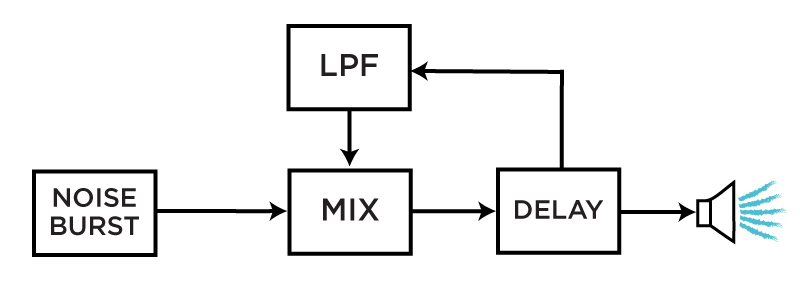 Simple Karplus-Strong diagram
Simple Karplus-Strong diagram
Full self-oscillation aside, there is another way to use delays as a type of sound generator: Karplus-Strong synthesis. First implemented by Alexander Strong and Kevin Karplus in the early 1980s, Karplus-Strong synthesis is a clever way of utilizing a delay line, filter, and an impulse to emulate the behavior of a plucked string. By sending a short impulse into a delay line with a lowpass filter inserted in the feedback loop, K-S synthesis produces ringing tones whose timbre darkens as the note decays. By altering the characteristics of the filter and the intensity of the feedback loop, the "ring time" can be extended; by altering the length of the delay line, different pitches can be achieved.
Try sending a short impulse or burst of noise into Mimeophon's audio inputs with repeats set fairly high and HALO at minimum: you'll generate sounds not unlike a plucked string. By varying COLOR, you emulate the purpose of the lowpass filter in traditional K-S synthesis—the sound will change in color as the tone decays, providing the additional opportunity for different means of gradual coloration. Try varying COLOR and Repeats for traditional K-S-like sonic alterations, and experiment with HALO for adding something unique into your string sounds.
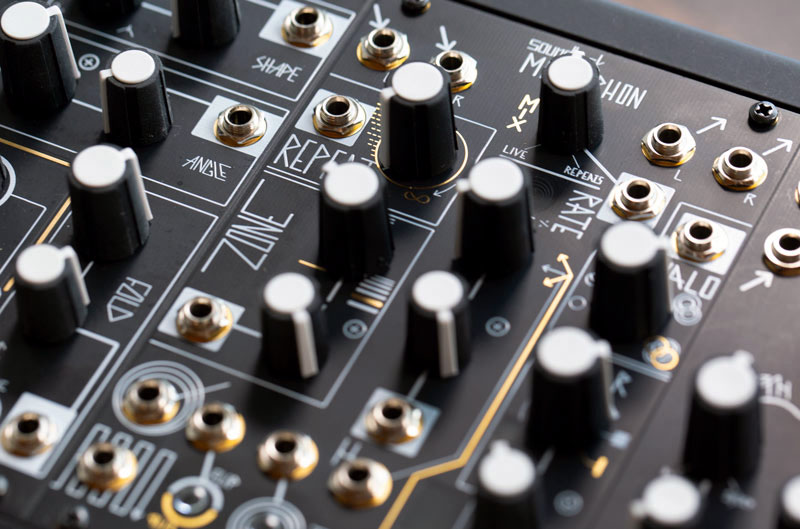
Another cool trick: try turning on SKEW and alternate which input your impulse is sent to—you'll produce trills and alternating tones that converge and diverge from one another when Rate is modulated. Additionally, when in ZONE 0, Skew does not affect the microRate input: so both delay lines can be made to maintain a Skewed rate ratio while you still control pitch via microRate. Combine this with the alternating impulse trill trick and the Mimeophon breaks well beyond the typical "delay as Karplus-Strong synth" bag of tricks.
Happily, Karplus-Strong works fairly well on most delays, analog and otherwise—because it isn't reliant on exploiting phase differences with incoming audio, it isn't impeded by the dark, murky nature of BBDs or other analog delay methods. Try it out on Doepfer's A-188-1A, for instance—it sounds great.
Vibrato and Chorus
Many time-based effects rely on doppler-style pitch shifting. This originated in the world of tape delay and analog BBD-style delays: basically, if the delay time is sped up while the delay loop is populated, the contents are compressed and sound higher than their original pitch. Conversely, if the delay is slowed down, its contents are stretched out and sound lower than their original pitch. By using an LFO to continuously sweep the delay time, the pitch will appear to raise and lower over time.
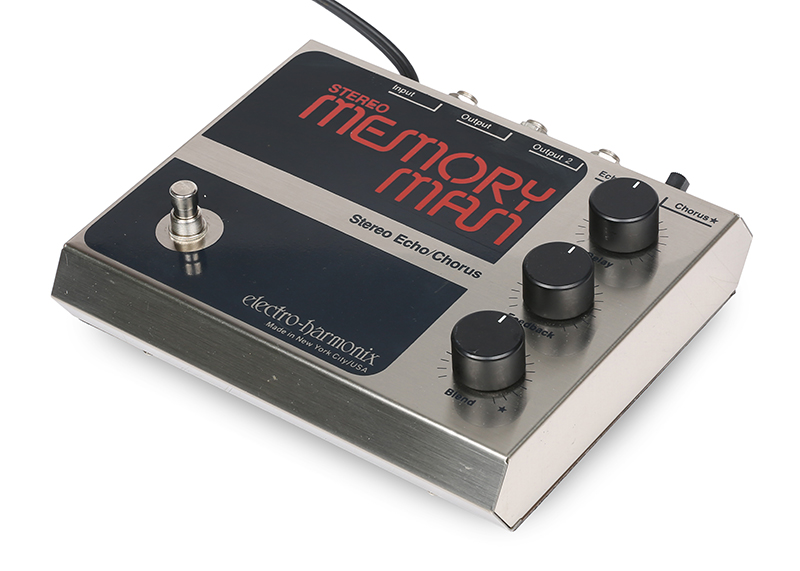 EHX Memory Man delay/chorus/vibrato
EHX Memory Man delay/chorus/vibrato
This is how "vibrato" in many classic delay pedals works: by setting the effect balance to be completely wet at a fast delay time with no feedback and repetitive modulation (from a sine or triangle LFO), a vibrato effect can be achieved. This type of effect can be achieved with any delay processor that allows for continuous delay rate modulation with doppler shift: happily, most modular delays can do this. On the Mimeophon, this can be achieved either with subtle RATE modulation, or by using the microRate input, which performs doppler-style modulation regardless the other settings.
Old-school chorus effects were achieved in much the same way. By adjusting the effect balance so that both dry and wet signals can be heard, subtle vibrato-type modulation combines with an input signal with more stable central pitch, creating continuously evolving detuning effects. Adding some feedback smears the edges between repeats, creating a lush sound straight from the '80s.
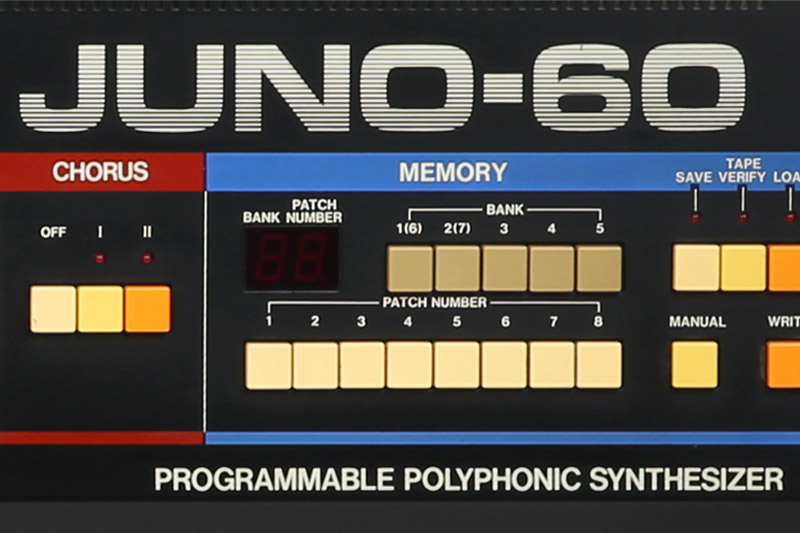 Chorus section on the Roland Juno 60
Chorus section on the Roland Juno 60
Perhaps the most famous chorus of this type is that found in the Roland Juno 60, a warbly chorus with a famously warm sound. The truly special thing about the Juno 60 chorus is that it uses two delay lines rather than one: one panned hard left, the other panned hard right. An internal LFO increases the speed of one delay while it decreases the other, creating a bizarrely deep, disorienting effect where one side shifts up in pitch as the other shifts down (and vice versa). Happily, the Juno chorus doesn't utilize particularly fancy technology to make this possible: similar effects can be achieved with most analog delays fairly easily.
Achieving this effect with a modular system would usually require two delay modules, a mult, and an inverter—using an LFO to control both delay rates inversely from one another. On the Mimeophon, though, the SKEW control makes this much simpler. By engaging SKEW, further changes to the RATE control inversely affect the left and right delay lines—meaning that huge, Juno-style chorus is dead simple to recreate. And of course, with the addition of COLOR and HALO, a whole other world of sounds becomes accessible.
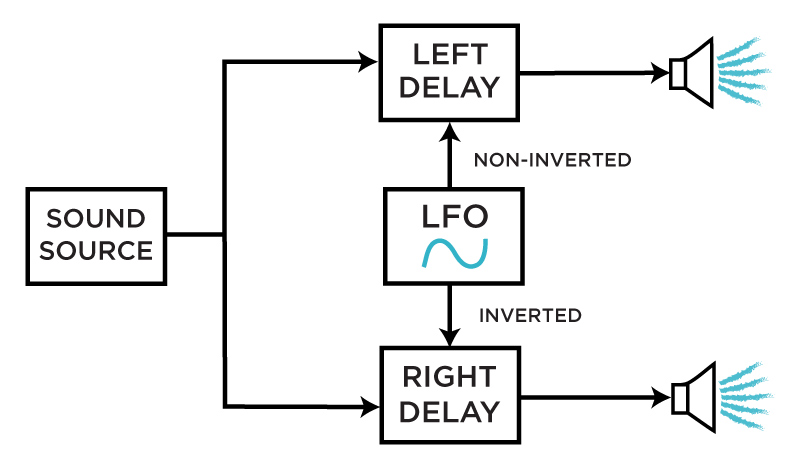 Delay modulation in traditional chorus effects
Delay modulation in traditional chorus effects
Note: the same type of modulation applied with greater intensity and longer delay times creates familiar extreme delay pitch bending effects. RATE modulation on the Mimeophon allows access to this type of extreme modulation effect; however, switching ZONEs maintains the original pitch of the incoming signal.
Additionally, when controlling RATE from an external clock, the doppler effect disappears...an altogether uncommon feature in most delays.
Looping and Time Lag Accumulation
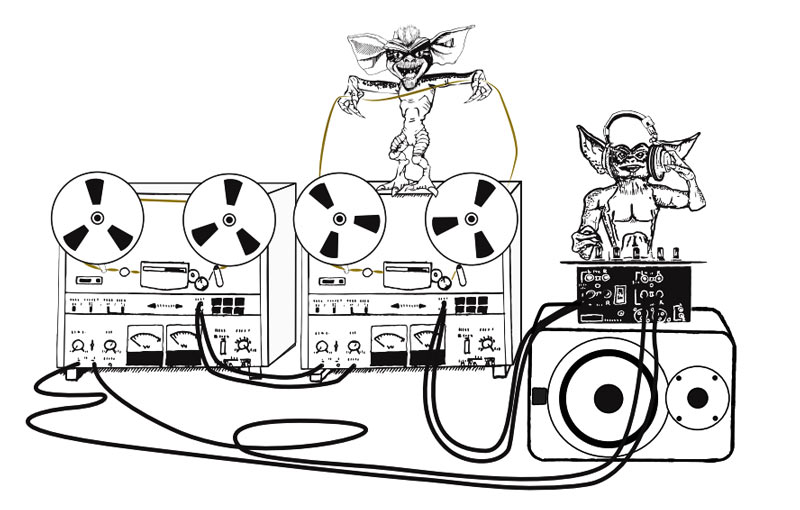 TLA Gremlins from the Morphagene manual
TLA Gremlins from the Morphagene manual
On the other end of the temporal spectrum from flanging and Karplus-Strong lies an entirely different type of musical effect: Time Lag Accumulation, an effect closely related to "looping." The term "Time Lag Accumulation" (TLA) was most noticeably brought into the Eurorack paradigm by Make Noise's Morphagene. The Morphagene manual illustrates TLA with two reel-to-reel tape machines and two Gremlins mischievously manipulating the sound in the feedback loop—and honestly, that's a pretty good explanation of what TLA is (also, Gremlins is awesome—thanks for reminding me, Make Noise!).
The term "Time Lag Accumulation" was coined by Terry Riley in order to describe a setup devised to record his piece Mescalin Mix. Two tape recorders were used in order to simultaneously record to and read the same tape; by looping the "read" machine's output back into the "record" machine's input, segments of audio would repeat themselves at an interval determined by the physical length of the tape itself (and the speed of the tape machine's motors). This produced a tape delay effect; by setting the input gain on the "record" machine at just the right level, sounds could be made to repeat themselves indefinitely, gradually changing in timbre and clarity with each repeat. Similar techniques were used in Brian Eno's Discreet Music (from which a technical diagram is included below), and the Brian Eno/Robert Fripp collaborative work No Pussyfooting. This style of sound-on-sound effect with long delay times was the first method of live looping: crude and colorful, but effective.
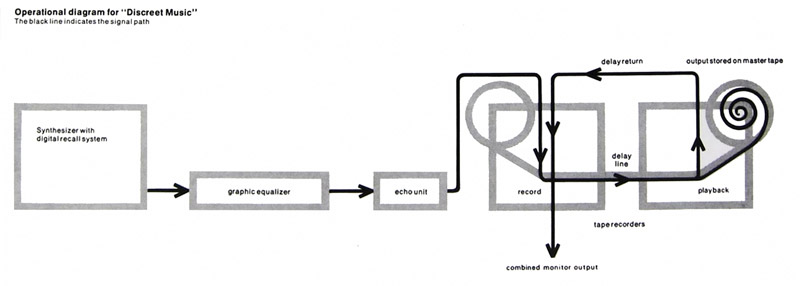
Time Lag Accumulation is somewhat different in purpose and approach from typical delay or looping. It differs from delay primarily as a function of its duration: it is no longer about producing echo effects, but about capturing entire phrases or large sections of a piece of music and repeating them at distant intervals. This is perhaps best exemplified in another Terry Riley piece called "Poppy Nogood and the Phantom Band," in which Riley seeds the Time Lag Accumulator in order to create spontaneous accompaniments with himself. In "Poppy Nogood," TLA does not produce "loops" based on specific meter or predictable repeats—instead, extreme delay times are used so that Riley intentionally could not keep track of when the repeats would cycle, creating a continuously evolving tapestry of loosely-interlocking textures.
Of course, modern loopers and live loop performance typically rely neither on the unpredictability of long loops or the unstable nature and timbral quirks of tape feedback. Modern loopers more commonly allow "punch in"-style recording into a continuously recording buffer, or otherwise allow recording into multiple separate buffers which all inherently have the same length—keeping things neatly in time with minimal alteration of sound quality as time progresses.
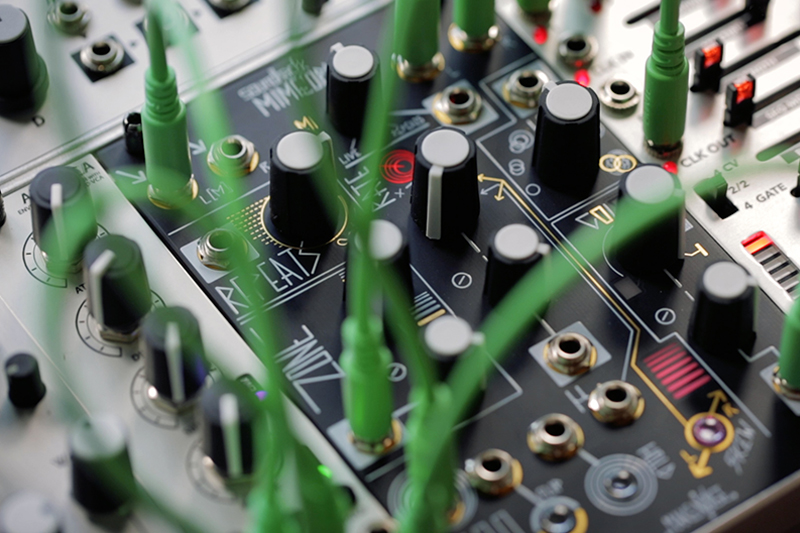 Mimeophon among the weeds
Mimeophon among the weeds
Mimeophon provides the best of both worlds. Because of the extreme range of delay times available (up to just under 42 seconds), it is easily possible to extend delay effects into the range of looping (or even to "HOLD" a buffer and allow it to repeat indefinitely). And of course, given the nature of the COLOR and HALO controls, it is possible for the sound to change in timbre with each repeat (a la classic TLA). Moreover, since all ZONEs are always actively recording, one can shift between small zones and large ones, hearing the cumulative effect of their activities in smaller ZONEs repeat when switching to larger ones. And of course, by using SKEW and the Ping Pong and Swap modes, repeats can unfold in a tremendous number of interlocking yet unpredictable ways—making Mimeophon a fascinating way to experiment with various looping techniques, tempo-synced or not.
All of the effects outlined above are, at the very core, based on the same techniques—but they are vastly different in affect. Because all of these effects are based around manipulation of delay lines, they can be produced with a huge range of devices: delay modules, effects pedals, plugins, and more. Due to Mimeophon's uncommonly wide range of available delay times, it can easily access all of these effects...but in practice, you might be surprised just how much utility you can get out of even a simple delay pedal.
And of course, there are other ways to manipulate delays: automatic double tracking effects, slapbacks, and more. If nothing else, a useful thing to internalize is that the boundaries between these effects are blurry—and these fuzzy boundaries are places where experimentation is particularly fruitful and exciting.








